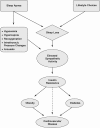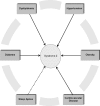Obstructive sleep apnea and cardiovascular disease: role of the metabolic syndrome and its components
- PMID: 18595441
- PMCID: PMC2546461
Obstructive sleep apnea and cardiovascular disease: role of the metabolic syndrome and its components
Abstract
Although obstructive sleep apnea and cardiovascular disease have common risk factors, epidemiologic studies show that sleep apnea increases risks for cardiovascular disease independently of individuals' demographic characteristics (i.e., age, sex, and race) or risk markers (i.e., smoking, alcohol, obesity, diabetes, dyslipidemia, atrial fibrillation, and hypertension). Individuals with severe sleep apnea are at increased risk for coronary artery disease, congestive heart failure, and stroke. The underlying mechanisms explaining associations between obstructive sleep apnea and cardiovascular disease are not entirely delineated. Several intermediary mechanisms might be involved including sustained sympathetic activation, intrathoracic pressure changes, and oxidative stress. Other abnormalities such as disorders in coagulation factors, endothelial damage, platelet activation, and increased inflammatory mediators might also play a role in the pathogenesis of cardiovascular disease. Linkage between obstructive sleep apnea and cardiovascular disease is corroborated by evidence that treatment of sleep apnea with continuous positive airway pressure reduces systolic blood pressure, improves left ventricular systolic function, and diminishes platelet activation. Several systematic studies are necessary to explicate complex associations between sleep apnea and cardiovascular disease, which may be compounded by the involvement of diseases comprising the metabolic syndrome (i.e., central obesity, hypertension, diabetes, and dyslipidemia). Large-scale, population-based studies testing causal models linking among sleep apnea, cardiovascular morbidity, and metabolic syndrome are needed.
Figures





References
-
- Partinen M, Guilleminault C. Obstructive sleep apnea syndrome. New York: Raven Press; 1990. Evolution of obstructive sleep apnea syndrome. In: Partinen M, Guilleminault C, eds; pp. 15–23.
-
- Guilleminault C, Connolly SJ, Winkle RA. Cardiac arrhythmia and conduction disturbances during sleep in 400, patients with sleep apnea syndrome. Am J Cardiol. 1983;52:490–4. - PubMed
-
- Hoffstein V. Blood pressure, snoring, obesity, and nocturnal hypoxaemia. Lancet. 1994;344:643–5. - PubMed
-
- Hoffstein V, Mateika S. Cardiac arrhythmias, snoring, and sleep apnea. Chest. 1994;106:466–71. - PubMed
-
- Yaggi HK, Concato J, Kernan WN, et al. Obstructive sleep apnea as a risk factor for stroke and death. N Engl J Med. 2005;353:2034–41. - PubMed
Publication types
MeSH terms
Grants and funding
LinkOut - more resources
Full Text Sources
Medical
